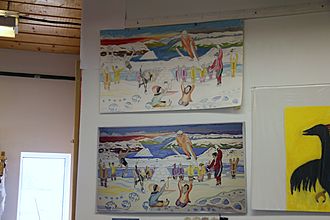- This page was last modified on 17 October 2025, at 10:18. Suggest an edit.
Uqqurmiut Centre for Arts & Crafts facts for kids
| Uqqurmiut Centre for Arts & Crafts | |
|---|---|

Tapestries at the Uqqurmiut Centre for Arts & Crafts
|
|
| Former names | Pangnirtung Tapestry Studio (1991) Craft Gallery (1991) Pangnirtung Print Shop (1994) |
| General information | |
| Type | Arts and crafts centre prints tapestry wallhangings |
| Location | Pangnirtung, Nunavut |
| Coordinates | 66°08′49″N 065°42′31″W / 66.14694°N 65.70861°W |
The Uqqurmiut Centre for Arts & Crafts is a special place in Pangnirtung, Nunavut, Canada. It was started in 1990 by the Uqqurmiut Inuit Artists Association. This centre helps Inuit artists from Pangnirtung share their amazing work with the world.
Even though Pangnirtung is a small, faraway community, its artists are very successful. They sell their prints, carvings, sculptures, and beautiful woven wall hangings. The Centre has a Tapestry Studio, a Craft Gallery, and a Print Shop. Since the 1970s, prints from the Print Shop have been released every year. The tapestries, or woven artworks, also became popular around the world.
The buildings at the Centre are designed to look like traditional igloos and skin tents. This design connects the modern art centre to ancient Inuit ways of life. In 2002, a big art show called Nuvisavik: the place where we weave was held. It showed many artworks from the Centre at the Canadian Museum of History in Ottawa.
Contents
About the Uqqurmiut Association
The Uqqurmiut Inuit Artists Association owns and runs the Uqqurmiut Centre. This group was officially formed in 1988. It is fully owned by Inuit people.
The word Uqqurmiut means "the people of the leeside" in Inuktitut. Pangnirtung is located next to a fjord called Pangnirtung Fjord. This fjord is on the side of a mountain that is sheltered from the wind, which is the "leeside."
Building Design
The newer buildings at the Centre are connected to each other. This design makes them look like large igloos. They also remind people of the traditional circular tents used in old Inuit settlements. This unique architecture connects the Centre to Inuit history and culture.
The Print Shop
The print shop at the Centre is about 2,300 sq ft (210 m2) in size. It was finished in 1994. The original print shop had burned down in 1993. Since the 1970s, the print shop has created special limited edition prints each year. These prints are known as the Pangnirtung Prints Collection. In 1999, the Uqqurmiut Inuit Artists Association showed their collection of 22 prints. These prints were displayed in 23 art galleries across North America.
The Tapestry Studio
The Pangnirtung Tapestry Studio is about 2,100 sq ft (200 m2). It was completed in 1990. Here, artists create beautiful woven tapestries.
The Craft Gallery
The Craft Gallery is about 1,400 sq ft (130 m2). It is a place where Inuit art and culture are shown and celebrated. Visitors can see and buy artworks made by local artists.
Featured Artists
Many talented artists have created art at the Uqqurmiut Centre. Here are two examples:
Elisapee Ishulutaq
Elisapee Ishulutaq was born in 1925 on Baffin Island. She started making art when she was in her forties. Her artworks often tell stories from her childhood in the 1920s and 1930s. During that time, she lived a traditional Inuit life, moving between hunting and fishing camps.
Elisapee moved to Pangnirtung around the time the Print Shop opened. She was very good at carving and drawing. She was one of the first artists to contribute to the annual Print Collection. In 1973, she won an award for one of her prints. By 2012, her tapestries and prints were displayed in major museums. These included the National Gallery of Canada and the Montreal Museum of Fine Arts.
Andrew Qappik
Andrew Qappik is famous for a large tapestry called "Our ancestors' land is our land now." This artwork is displayed at the Visitors' Centre in Iqaluit, the capital of Nunavut. Andrew also designed the flag of Nunavut.
When Andrew was 11 years old, he watched his uncles, Solomon and Imoona Karpik, make prints. They worked in the print shop. In 1978, a history professor named H.G. Jones noticed Andrew's art. Andrew was only 14 at the time. Jones was interested in Andrew's pictures of Inuit life from the past.
By 1999, Jones had collected all 69 limited edition prints made by Andrew. Jones loved the Arctic landscape around Pangnirtung. He visited Pangnirtung almost every year for 31 years. He bought every print Andrew made, including etchings and stone cuts. In 2006, Jones gave his collection of 140 of Andrew's prints to the Winnipeg Art Gallery. This gallery has the world's largest collection of Inuit art. Andrew Qappik had his first solo art show at this gallery in 2010. His 2003 print is a self-portrait of him working at the print press in the Uqqurmiut Centre.
